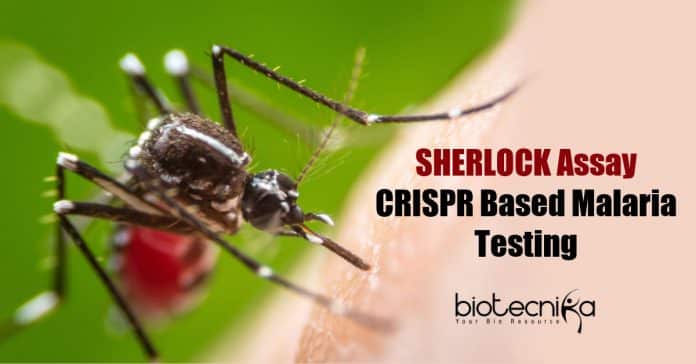SHERLOCK assay – CRISPR-based malaria testing
It is vital that all local spread of malaria parasites in specified geographic locations is annihilated to attain the aim of eradicating malaria established by the Global Malaria Control Programme by WHO. The advancement of species-specific, rapid, and sensitive diagnostic abilities that are beneficial in the LRSs – low-resource settings of several areas with endemic malaria is a major cornerstone on this path.
Presently, the presence of the 4 significant malaria-causing Plasmodium species Plasmodium falciparum, Plasmodium vivax, Plasmodium ovale, and Plasmodium malariae is determined by quick diagnostic tests for certain Plasmodium proteins (antigens) or by microscopic evaluation of blood samples in which parasites can be identified in RBCs.
Nira Pollock, Associate Medical Director, Boston Children’s Hospital’s Infectious Diseases Diagnostic Laboratory stated that the available rapid diagnostic methods are inefficient for detecting fewer quantities of Plasmodium parasites in asymptomatic individuals and can’t differentiate all 4 Plasmodium species, which is necessary to start the precise therapy.
Jeffrey Dvorin, Senior Associate Physician, Boston Children’s Hospital said that these asymptomatic carriers are silent reservoirs for ongoing spread by malaria-spreading mosquitoes and very essential for continuous worldwide attempts to eliminate malaria.
A field-applicable, ultrasensitive diagnostic assay that especially identifies
DNA sequences from all Plasmodium species in asymptomatic and symptomatic malaria was developed by an interdisciplinary study association, and the outcomes of the study are released in the journal PNAS. To allow extremely specific and sensitive Plasmodium detection in 60 minutes in simple reporter devices, the novel malaria diagnostic approach combines the CRISPR-based SHERLOCK (short for Specific High-sensitivity Enzymatic Reporter unLOCKing) system with an optimized 10-minutes rapid sample preparation procedure.James Collins stated that this market-ready assay goes beyond the needs set by the WHO for the desired test that can be used to identify low parasite density in asymptomatic carriers providers of all significant Plasmodium species in case of sensitivity as well as specificity.
The researchers described their engineered SHERLOCK assay to be efficient in detecting less than 2 parasites per microliter of blood, which is the WHO’s recommended: “limit of detection” (LOD) for a test with wide use in endemic locations. The team called out the assay with 100% sensitivity, by correctly recognizing positive samples, and 100% specificity, by appropriately identifying samples lacking a certain Plasmodium species in true negative samples – Revealing the clinical potential of the assay by examining clinical samples consisting of Plasmodium falciparum and Plasmodium vivax species. The vital properties of diagnostic assays to be utilized in actual-world testing is near cent percent sensitivity and specificity. Additionally, the assay is devised so that it can detect the regularly mutated Plasmodium falciparum strains that have actually lost their HRP2 antigen and thus escape from the typical rapid analysis test detections.
The SHERLOCK technology was developed by Collins’ group at the Wyss Institute, MIT, and Feng Zhang’s group, the Broad Institute.
Various other techniques have been created that, such as the new SHERLOCK assay, carry out amplification and detect the nucleic acid product of Plasmodium species, but, till now, these approaches remain limited by their requirement for pricey lab devices, like PCR based methods, complicated sample preparation methods, as well as skilled employees or, “isothermal” amplification approaches carried out at a single temperature, they haven’t shown the desired sensitivities in this area.
The enzyme CRISPR-Cas12a which can be made to become active with a guide RNA that binds to a certain nucleic acid target sequence benefits this SHERLOCK assay. In this case, it is a sequence from one of the 4 Plasmodium species. With a very high turn-over rate of nearly 1,250 collateral cleavage reactions/seconds, the activated Cas12a after that non-specifically cleaves any single-stranded DNA strand in its proximity. The team used this amplifying activity in their assay by incorporating it with optimized sample preparation, which doesn’t require an isothermal amplification of specific Plasmodium DNA and RNA sequences, and a particular nucleic extraction step like some other NAATs.
The activity of Cas12a is unleashed by the guide RNAs that identify species-specific motifs in the amplified Plasmodium sequences. This additionally attacks the single-stranded DNA reporter sequences whose cleavage products aid indicate the pathogen-specific nucleic acids’ presence. The signal is directed to either trigger a difference in fluorescence in a hand-held tool or a particular band on a lateral flow strip usually employed in medical tools.
Rose Lee, the first author and a fellow in Collins’ group said that the assay works with various sample types, such as plasma, whole blood, serum, and also dried out blood, and all components needed for amplification, Cas12a activation, and signal generation can be lyophilized in a single test tube so that it works together in a one-pot-reaction after they are reconstituted and the patient’s sample is combined. This prevents the need to depend on a useful cold-chain as well as permits testing to be carried out in low-resource setups with marginal experience.
Don Ingber, the Wyss Institute’s Founding Director said that the partnership’s molecular assay for malaria diagnosis shows how knowledge in epidemiology and infectious disease biology, might alter the way of attenuating illnesses that disable populaces worldwide.
Author: Sruthi S






























